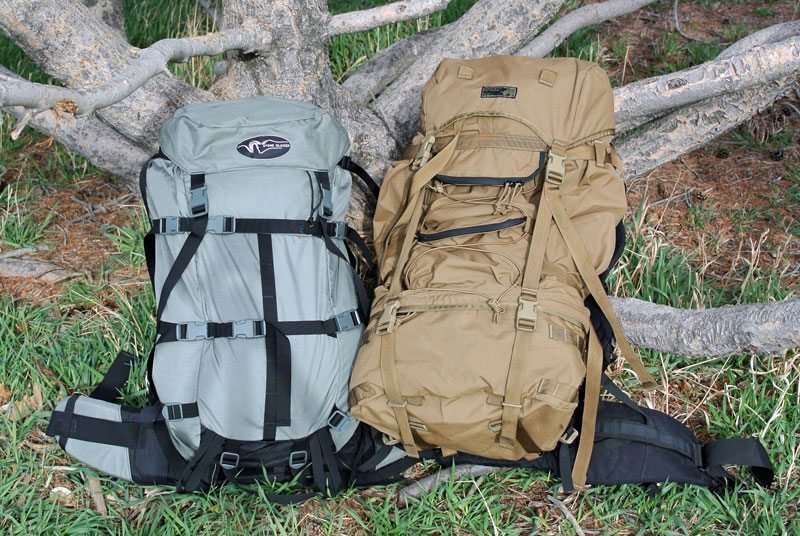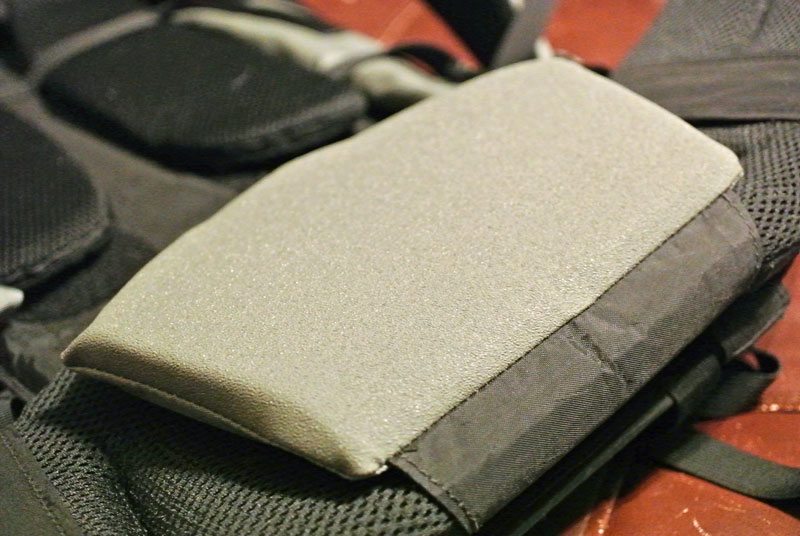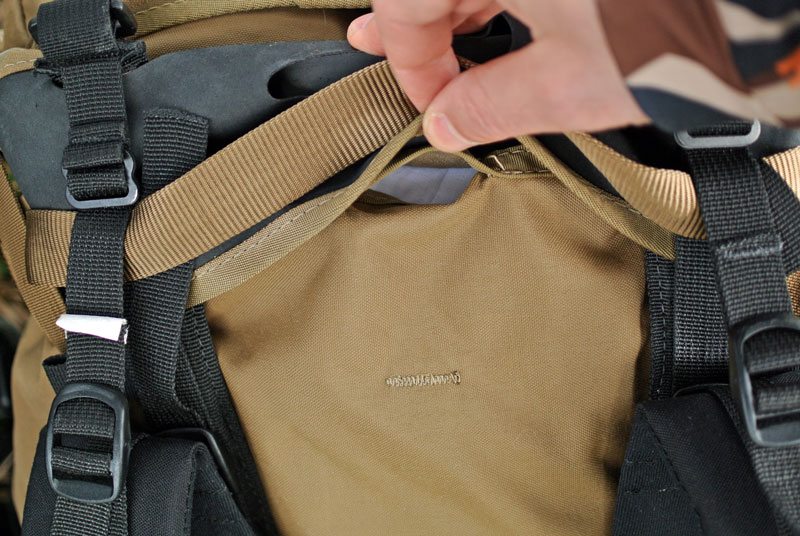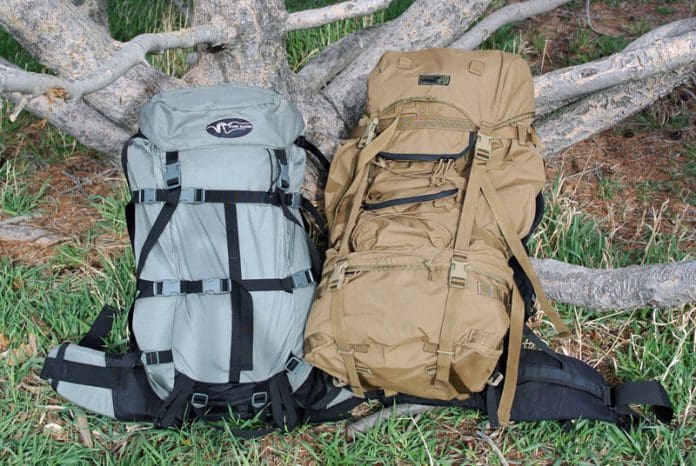Elite Hunting Packs – Kifaru and Stone Glacier
By Matt Cashell

Stone Glacier (left) and Kifaru provide back-country hunters with excellent options for toting gear in and trophy game out
Innovation is the name of the game in the hunting pack market. Lately, modular backpacking designs are really gaining in popularity with the backcountry hunting crowd. Comfortable suspension, heavy load ratings, and versatile modularity are keys to the high-end packs.
Two companies catering to this growing market are Kifaru International and Stone Glacier Packs. Kifaru is an established hunting pack leader, founded in 1997 by Patrick Smith, who had previously founded Mountainsmith in 1979. Stone Glacier is new, founded by Kurt Racicot in August 2012. Both company founders weren’t finding the packs they quite wanted, and so they began making their own.
Here in 2013 we have two ultra light frames the packs are based on. The Stone Glacier Krux is a fabric-covered polycarbonate sheet frame with crossed carbon rod stays. The suspension attaches via hook-and-loop for both the waist belt and shoulder straps. The belt is a more traditional fabric-covered foam, as are the shoulder straps. A supplemental attachment for additional lumbar support was provided with the pack for testing. The belt tightens in the traditional manner at the buckle.

Stone Glacier’s easy to adjust suspension features hook & loop attachment
The Kifaru bikini frame is a skeletonized version of the venerable Duplex frame. It has composite (laminated carbon fiber/hardwood) vertical stays riveted to two composite horizontal stays. The Bikini is available in two frame sizes, based on the length of the vertical stays: 24 inch and 26 inch. I opted for the 26 inch stays, as this provided more lift adjustment. However, since I am 5’-9”, when I lean my head back with the Bikini, I can contact the upper horizontal stay. It isn’t much of an issue in the field for me, but the 24 inch stays would probably provide a little more headroom. The Kifaru belt is much wider than the Stone Glacier, with soft, conforming memory-foam style padding. It has a thick and firm lumbar support. The shoulder straps were thinner than the Stone Glacier. The belt adjusts with a side release buckle, but had mechanical advantage in the power-pull design.

Kifaru’s luxurious hip-belt
There are several packbags available for both frames. The Kifaru Bikini frame is backward-compatible with all Kifaru packbags including the older designs. It also accepts scads of Kifaru accessories including add-on pockets, gun bearers, the versatile Grab-It, etc. Kifaru’s accessory options are staggering but luckily helpful staff are there to get the customer into the right options. I received the largest 7200 cubic inch (ci) DT1 version of the Timberline bag and the smaller 4800 ci High Camp series bag. Both bags are made from 500D Cordura ripstop fabric.
The Stone Glacier line of packbags includes the 3300 ci Solo, the 6000 ci Terminus, and now the 2271 ci Approach day pack. These packs are also constructed of 500D Cordura, with Xpac water-resistant fabric on the meat shelf. I received the largest Terminus model for testing. The Stone Glacier also has belt pouch accessories and a reinforced spotting scope pocket available. The new Approach day pack can be added either the Solo or Terminus bags to increase volume and versatility. This feature would allow the hunter to leave the big packbag at camp and run the Approach and Krux for day hunting from camp.
Suspension:
These packs suspensions have some things in common: They are comfortable, adjustable, and supportive. Both brands are a class above the “off the shelf” hunting bags in these categoreis thanks to their superior suspension systems. Both frames provide functioning load lifters between the shoulder straps and the top of the frame.

Adjusting the Krux was a breeze: You simply move the torso pad to the correct spot on the frame and firmly press the hook and loop together. This method leaves infinite fine adjustments for each side independently. It took me seconds, and I had the straps adjusted as instructed by Kurt on his web tutorials. Adjusting the belt was a straightforward affair. Just snapping the side release buckle and pulling on the each belt strap snugged it up. I was able to get a firmer pull by doing one side at a time, but not nearly as easily firm as I did with the Kifaru belt. Once attached, the frame stayed squarely in place for me. I tried the belt both with, and without, the lumbar support. Both options were comfortable to me, but I preferred the extra support of the lumbar accessory.

Stone Glacier Lumbar Accessory Pad
The Kifaru took a little more work for fitting: There are two three bar sliders under the torso pads. In order to adjust, I had to undo the webbing from the sliders, adjust the shoulder straps, and rerun the webbing through the three bar sliders. This method required a little trial and error, but with some effort I had it set just right. The robust system did give me a little more confidence that it wouldn’t be coming out of adjustment. A nice touch on the Kifaru is that the load lifters are adjustable in angle, which allows individual users get their preferred amount of “lift.“ The belt on the Kifaru is a dream. The softer foam molds perfectly over your hipbones, providing a supportive hug. The power-pull belt’s mechanical advantage ensures a tight fit with minimal effort. Once adjusted to Kifaru’s recommendations, It was locked-in and comfortable.
The frames were both vertically rigid. The Bikini was more torsionally rigid, while the Krux had more flex. I had zero issues with the Bikini “barreling” (arcing with a high volume load), but soft loads between the frame and the bag can intrude between the vertical stays. The Krux did barrel slightly, but once the pack was on the back, and snugged up, this was a non-issue.
Features:
The High Camp and Terminus are basically top-loading duffels that attach to the frame. The Terminus has an interior stash pocket (sized just right for a Rokslide Kill Kit) and a lid pocket for frequently needed items like snacks, GPS, etc… Otherwise if you are getting something off the bottom you’ll be digging through your stuff. The High Camp is similar, although there are several lid options and a U-shaped, zippered access typically used for a sleeping bag at the bottom. This access was nice not only for your sleeping bag, but it also gave another point to access the bag’s interior.
The Duplex Timberline is a top loader with two open-topped vertical side pockets, and two sewn-in back pockets. The sleeping bag access is zipped from one side of the bag to the other. I preferred the basic functionality this additional organization provided – particularly, the ability to leave the bag fully loaded and secure, but still access essentials like food or sunscreen from the exterior.

Kifaru Hydration Port
Both the High Camp and Terminus had hanging loops for hydration bladders, and ports for hydration hoses. The Timberline 1 added a full pocket for a hydration bladder. The Terminus had a slightly larger port for the hydration hose, but snaking the mouthpiece/quick connect systems through the port in either pack required some effort and the typical amount of frustration.

Stone Glacier Hydration Port
Haulin’ Meat:
The quintessential purpose of any hunting pack is that it’s the only way to haul your trophy back to the truck.
Stone Glacier has a slick and well-executed feature for this purpose – an integrated meat shelf. The successful hunter simply unbuckles and unstraps the packbag from the frame, lays the meat against the frame and compresses the load to the frame with the packbag. Many people are concerned about this pushing the gear load too far away from their body. In my testing with loads of sand in the meat shelf, I didn’t have any issue with the load handling at all.
Kifaru offers a “Heavy Load Out” kit for the High Camp (and new DT bags), that forms a meat shelf with the bikini in a similar fashion. The accessory can be attached at the bottom of the bag, or further up on the frame, raising the load a little. It worked well and in a similar fashion as the Terminus, but I didn’t find it as easy or as integrated as I did the Stone Glacier execution of the concept.
I also hauled the load packed inside the bag with gear, in the traditional manner. I liked this method with the Kifaru, as I could easily get the load in and secure it with gear. Finally, there was the “Generation 2 Hanging Meat Bag.” I really liked this method with the Kifaru. You simply load your meat in the meat bag, and hang it from connectors on the inside of the bag or top of the frame. The load stays centered and elevated without effort, and is easy to pack gear around. This method seemed to segregate meat from the gear load just as well as the “between-bag-and-frame” method.
My preference would be to use the integrated meat shelf with the Stone Glacier, and the Gen 2 Meat Bag with the Kifaru. Both are extremely convenient, and well-executed designs.
Durability and Craftsmanship:
Both bags are well made with quality materials and sturdy threads. The stitching on both bags was obviously well thought out and sewn by skilled craftsmen. The Kifaru had a slight edge with a consistent, great looking sewing finish. I put the bags through significant durability testing which included many loadings, unloading, throwing loaded bags off of cliffs, rolling loaded bags off mountains, and power washing bags with frames attached. I had hardly a blemish, and not a single lost stitch or weld. A round of applause for these packs!

Actual weights:
The Stone Glacier Terminus with the lumbar accessory attached weighed in at 4 pounds and 4 ounces on my scale.
The Bikini w/ Highcamp 4800 weighed in at 4 pounds 5 ounces.
The Bikini w/ T1 bag ran the scale up to 5 pounds 11.6 ounces.
Recommendations:
Both of these pack systems are easy to recommend. Both handle heavy loads capably. Both have room for your gear, camp, and the buck you just tagged. Both systems offer high-volume packs that compress to nearly nothing.
While the similarities are there, so are the differences. The Krux fits tightly to the back, giving an impression of the bag being physically closer. The Bikini’s skeletonized frame and thicker torso pads give an impression the bag is slightly further away from your body, but also allows for better airflow around the back. The Krux’s framesheet provides a stable platform for attaching loose loads in the load shelf, while the super-rigid Bikini can allow loose loads to sneak between the vertical stays. The Krux’s belt is well padded and sufficiently comfortable, while the Kifaru is in its own league of support and comfort. The Kifaru bags had two points of access to the gear load, while the Terminus required digging in from the top.
Is there a clear winner? Yeah, backpack hunters are the winners! The hunter looking for an ultra light, integrated, simple, yet functional design would do well with the Stone Glacier. The hunter looking for the most modular, versatile design is going to find the Kifaru better suited. While I would be more than happy to use either system for my trips into the backcountry, and plan to continue using both, the most functional combination for me was the Bikini/Timberline 1 frame and bag combination. While this was the heaviest option I tested, it was also the most featured, with just the right amount of organization and exterior access for my needs.
Wish List:
A couple things I would prefer on these packs:
Gear Access: While the Kifaru offerings offered bottom access, which was beneficial, all of the packs would benefit from some sort of vertical zippered access.
Hydration ports: I have a hard time figuring out why hydration ports aren’t larger on backpacks, to make getting the mouthpiece/ quick connect systems through without a hassle.
Conclusion:
These pack systems are at the top of the list of super packs for the ultra light hunter. They are lightweight, capable of hauling ridiculous loads, and comfortable. While some hunters may find one more to their liking than the other, both will serve a wide variety of serious hunters. While both systems require a significant investment from the hunter, the quality and durability of these packs is worth the price of admission. Kifaru International lives up to their well-established name in the outdoor industry while newcomer Stone Glacier provides the very top of the market a legitimate competitor right out of the gate. Innovation is the name of the game for both companies and look forward to what’s next.
Aron Snyder of Kifaru International and Kurt Racicot of Stone Glacier were extremely helpful and supportive throughout the testing. I can confidently say that their customers are in good hands.



















